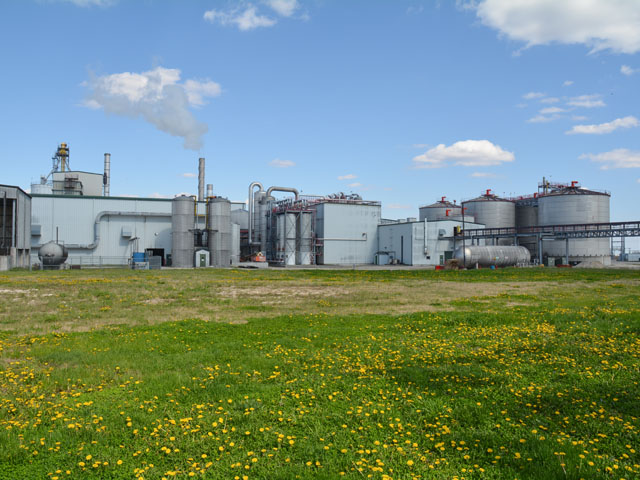Ethanol Shows Signs of Life
Falling Stocks, Rising Fuel Demand Helps Industry
OMAHA (DTN) -- Under normal circumstances, an improvement in ethanol margins would be celebrated in the industry. Yet the economic shutdown from COVID-19 has been far from normal.
In the past few months, oil has been cheap, gasoline has followed in response to a crash in demand and ethanol plants have been left with higher-priced product sitting in tanks, but there are signs of a slow recovery for the ethanol industry.
"A good sign that ethanol plants are ramping up production can be seen in the additional offers seen in the DDG (dried distillers grains) market," DTN Cash Grains Analyst Mary Kennedy said.
"Prices have returned to pre-COVID-19 levels, and in some cases, are weaker. Cash corn prices for the week have seen support from a slight improvement in basis as plants begin to seek out old-crop corn supplies. While ethanol plant corn demand may be slowly picking up, most farmers are not in the selling mood right now."
According to industry estimates, about 140 of the more than 204 ethanol plants across the country have either idled or cut back production during the COVID-19 crisis.
"We're starting to see things become more stable as demand comes back," Eric Mosbey, general manager at Lincolnland Agri-Energy, LLC, in Palestine, Illinois, said during a University of Illinois farmdoc webinar this week.
"We're starting to see customers increase their orders."
Weekly gasoline demand hit a low of 5.07 million barrels per day (bpd) in April, according to data from the U.S. Energy Information Administration. The latest numbers show weekly demand at 7.4 million bpd so far in May. Prior to the economic shutdown, demand peaked at 9.7 million bpd.
P[L1] D[0x0] M[300x250] OOP[F] ADUNIT[] T[]
In addition, ethanol production has begun to slowly increase.
Production plummeted from 1.079 million bpd at the beginning of March, to 537,000 bpd near the end of April. According the latest EIA data, production has increased to 617,000 bpd.
As a result of production reductions across the industry, farmdoc reports ethanol stocks have fallen from 27.69 million barrels in the middle of April to 24.19 million barrels in the middle of May.
DTN HYPOTHETICAL ETHANOL PLANT
If numbers were all that mattered in gauging the health of the industry at the present time, then a dramatic improvement in margins since the end of February would paint a promising picture.
DTN's Neeley Biofuels hypothetical ethanol plant has seen a substantial improvement since our last update on Feb. 20.
As of Thursday, the plant was reporting a net loss of 16.1 cents per gallon, including debt service. On Feb. 20, the plant reported a net loss of 31.8 cents per gallon. Most ethanol plants are not paying debt. If the hypothetical plant was not paying debt, it would be seeing a 15-cent, per-gallon profit in this latest update.
With markets in turmoil in recent months, the price of corn paid by the plant plummeted from $3.80 per bushel based on the Chicago Board of Trade futures price on Feb. 20, to $3.17 for this update.
With ongoing supply chain issues and struggling demand for transportation fuel, the ethanol price received by the hypothetical ethanol plant based on the rack price was $1.27 per gallon for this update. Early on in the COVID-19 shutdown, ethanol prices plummeted to historical lows in the 60- to 70-cent range.
The price received for distillers dried grains came in at $135 per ton, down from $140 on Feb. 20.
"Ethanol plants will need to see better margins, and even though gasoline demand has picked up, ethanol still remains a premium to gasoline and that will need to change in order to reintroduce discretionary blending, which in turn adds to ethanol demand," Kennedy said.
DTN established Neeley Biofuels in DTN's ProphetX Ethanol Edition as a way to track ethanol industry profitability. Using the real-time commodity price data that flows into the "corn crush" in ProphetX, and some industry-average figures for interest costs, labor and overhead, DTN is able to track current profits. It also tracks how much Neeley Biofuels would make or lose under an infinite number of "what-if" scenarios.
DTN uses industry-average figures from Iowa State University. Included in the figures are annual labor and management costs, transportation costs, debt-servicing costs, depreciation and maintenance costs. Although Neeley Biofuels is paying debt-service and depreciation costs on its plant, many real plants are not in debt.
Also, it should be noted the calculations include all other costs, such as chemicals and yeasts, electricity, denaturant and water. While DTN uses natural gas spot prices for these updates, many ethanol plants lock in prices on the futures market, so they are not as vulnerable to natural gas market volatility.
Todd Neeley can be reached at todd.neeley@dtn.com
Follow him on Twitter @toddneeleyDTN
(c) Copyright 2020 DTN, LLC. All rights reserved.




